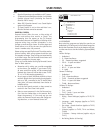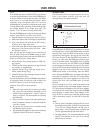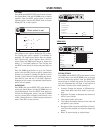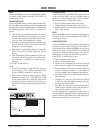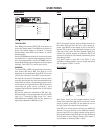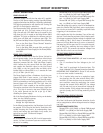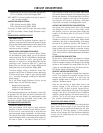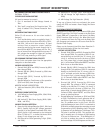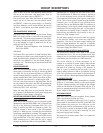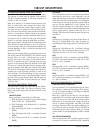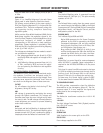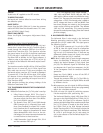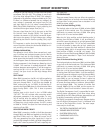
CIRCUIT DESCRIPTIONS
PV154 - 923-03506 3-2 ZP26/28 - SERVICING
· Shorted SW +5V (IC02) on Signal PWB through PRO-
TECT 1 to (D940) on Sub Power Supply PWB
NOTE: PROTECT 1 will not go below 2.2V even if the 5V or
the 3.3V lines are open.
VOLTAGE TOO HIGH DETECTION
· STBY +9V monitored by (D933, D934)
· STBY +5V monitored by (D935, D936)
If any one of these circuits activate, the power supply
will STOP and create a Power Supply Shutdown Condi-
tion.
POWER SUPPLY SHUTDOWN CIRCUIT
SHUTDOWN CIRCUIT
There are a total of 6 individual Shutdown inputs. In
addition, there are 3 Hot Ground side Shutdown inputs
that are specifically detected by the main power driver
IC I901. These sensors circuits protect I901 from
excessive current or voltage.
POWER SUPPLY SHUTDOWN EXPLANATION
This chassis utilizes IP01 as the Osc.\Driver \Switch
for the Deflection power supply, just as the previous
chassis have done. This IC is very similar to the previous
versions. The Shutdown circuit, (cold ground side
detection), is used to turn off the Relay S901 via the
following circuit, Connector PQD2 pin 1, Q916 the
Relay Driver on the Sub Power Supply PWB and the
Relay S901 also on the Sub Power Supply PWB.
The Power Supply utilizes a Shutdown circuit that
produces a High from 12 different sources. When any
of these inputs cause a high on the Connector PQD2
pin 1, the relay disengages, disabling the deflection
power supply.
All of the Power Supply Shutdown circuitry can be
broken down into the following groups;
· Voltage Missing Detection
· Excessive Current Detection
· Voltage Too High Detection
In the following explanation, the Shutdown circuits will
be grouped. This will assist the Service Technician with
trouble shooting the Chassis, by understanding these
circuits and having the associated circuit routes, the
technician can then “Divide and Conquer”.
SHUTDOWN DETECTION CIRCUITS
EXCESSIVE CURRENT DETECTION
One very common circuit used in many television
products is the B+ Excessive Current Sensing circuit.
In this circuit is a low ohm resistor in series with the
particular power supply, (labeled B+ in the drawing).
The value of this resistor is determined by the maximum
current allowable within a particular power supply. In
the case of Figure 1, the value is shown as a 0.47
ohm, however it could be any low ohm value. When
the current demand increases, the voltage drop across
the resistor increases. If the voltage drop is sufficient
to reduce the voltage on the base of the transistor,
the transistor will conduct, producing a Shutdown
signal that is directed to the appropriate circuit.
VOLTAGE LOSS OR EXCESSIVE LOAD DETECTION
The second most common circuit used is the Voltage
Loss Detection circuit. This is a very simple circuit
that detects a loss of a particular power supply and
supplies a Pull-Down path for the base of a PNP
transistor.
This circuit consist of a diode connected by its
cathode to a positive B+ power supply. Under normal
conditions, the diode is reversed biases, which keeps
the base of Q1 pulled up, forcing it OFF. However, if
there is a short or excessive load on the B+ line, the
diode in effect will have a LOW on its cathode, turning
it ON. This will allow a current path for the base bias
of Q1, which will turn it ON and generates a Shutdown
Signal.
B+ VOLTAGE TOO HIGH DETECTION
In this circuit, a Zener diode is connected to a voltage
divider or in some cases, directly to a B+ power supply.
If the B+ voltage increases, the voltage at the voltage
divider or the cathode of the zener diode will rise. If
it gets to a predetermined level, the zener will fire.
This action creates a Shutdown Signal.
NEGATIVE VOLTAGE LOSS DETECTION
The purpose of the Negative Voltage Loss detection
circuit is to compare the negative voltage with its
counter part positive voltage. If at any time, the
negative voltage drops or disappears, the circuit will
produce a Shutdown signal.
There are two resistors of equal value. One to the
positive voltage, (+12V) and one to the negative
voltage, (-12V). At their tie point, (neutral point),
the voltage is effectually zero (0) volts. If the negative
voltage is lost due to an excessive load or defective
negative voltage regulator, the neutral point will go
positive. This in turn will cause the zener diode to
fire, creating a Shutdown Signal.
DEFLECTION SHUT DOWN CIRCUITS
There are a total of 12 Cold Ground Side individual Shut
down inputs. There are also 3 Hot Ground Side Shut
down inputs that are specifically detected by the main
power driver IC, IP01 that protect it from excessive
current or over voltage. All of the Shut down detection
circuits can be categorized by the four previously
described circuits.




